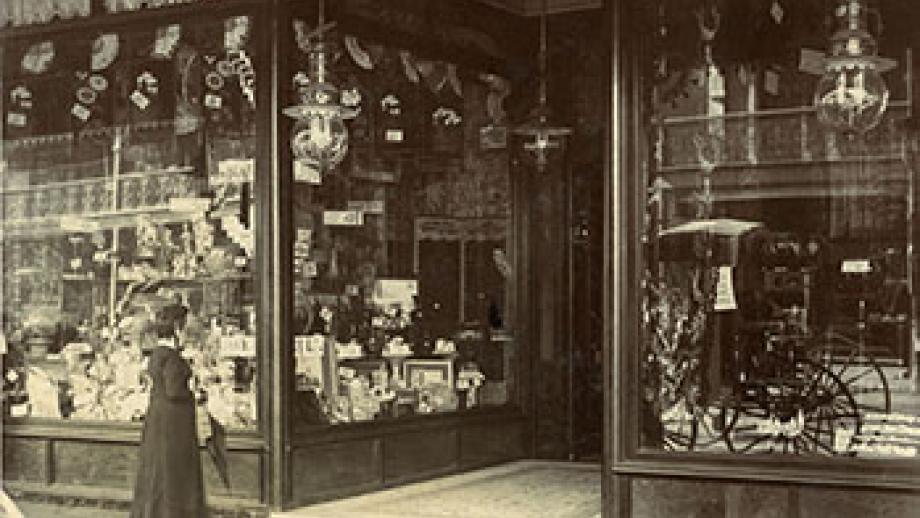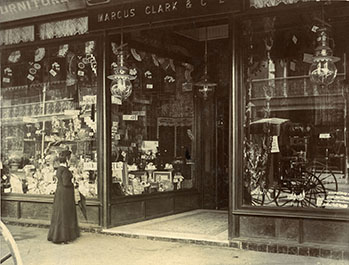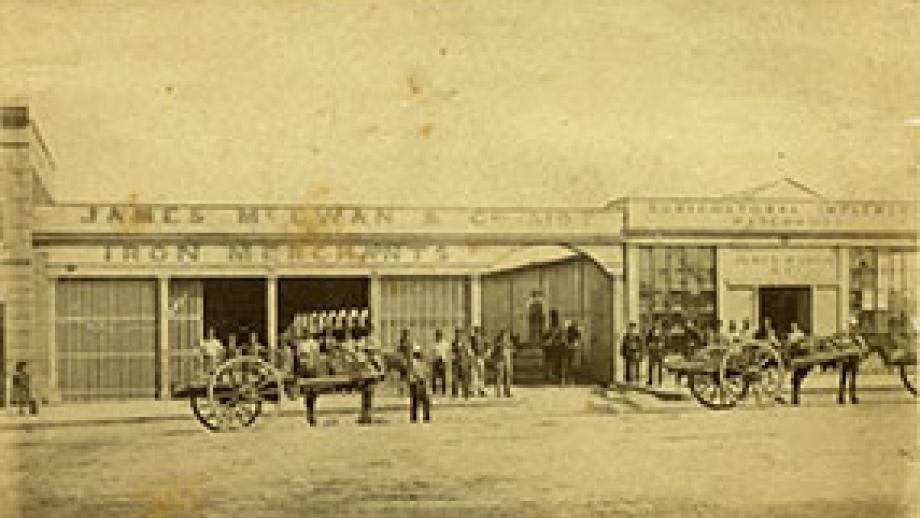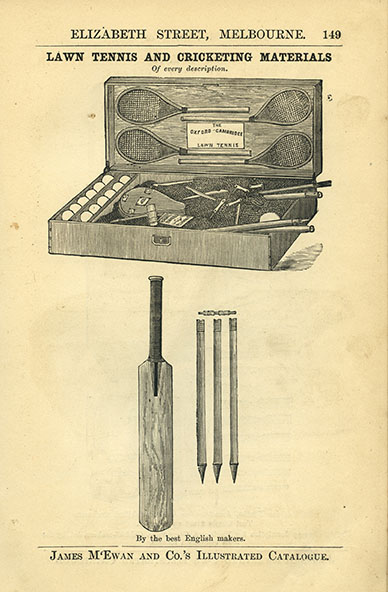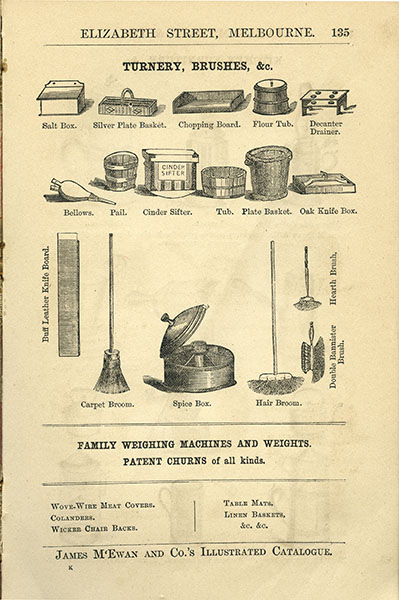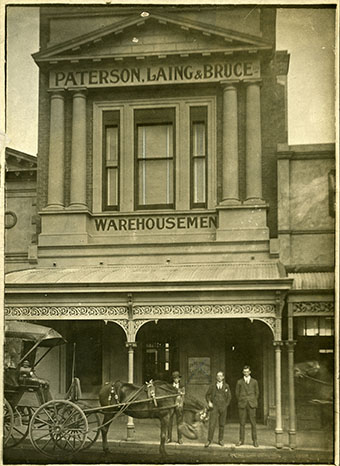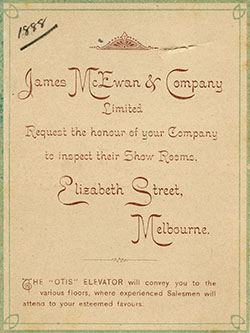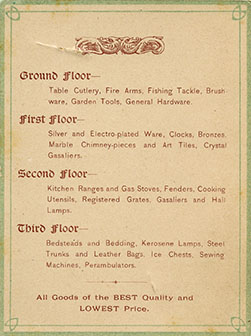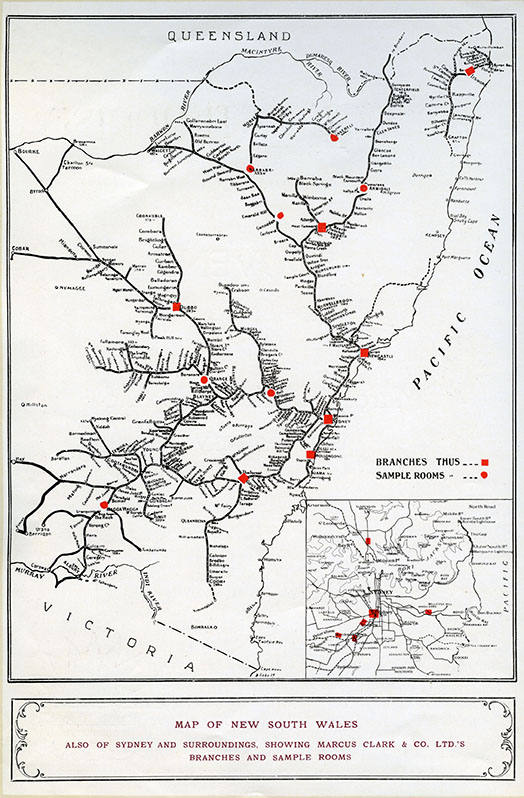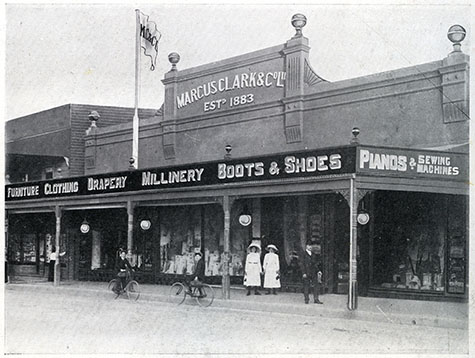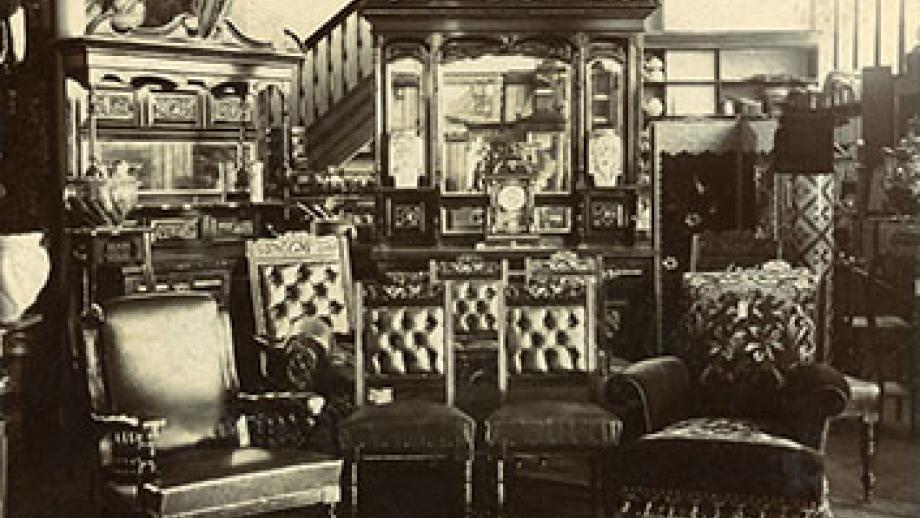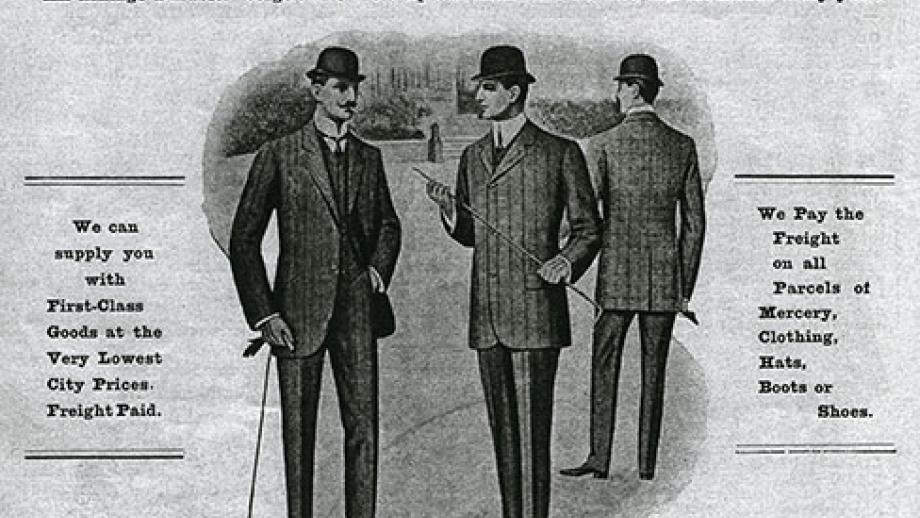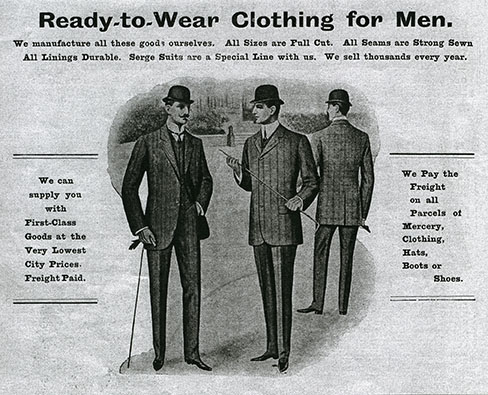Department Stores
Department Stores
By the middle of the 19th century there were department stores in most major Australian towns and cities.Some were originally drapers which had expanded naturally from haberdashery to furnishings and other household equipment. Others were ironmongers who had added frying pans, tin kettles, boots, hats, tools and sporting goods to their range. Larger firms combined wholesaling with retailing. Most successful retailers relied on an imagined reflection, a memory several stages removed, or a vague idea of shopping in London or Paris.
Marcus Clark & Company Limited (1883-1965)
From a modest start in the Sydney suburb of Newtown in 1883, Marcus Clark and Company rose to become one of Sydney’s largest department stores with a network of branches in towns and suburbs across Australia. Henry Marcus Clark (1859-1913) established the company, in 1883, after purchasing the drapery business of his former employer, John Kingsbury. The business quickly expanded, trebling itself within five years, and soon opened new stores in Marrickville and Bondi Junction. The Sands Directory for 1894 listed Marcus Clark as a ‘wholesale and retail draper, tailor, milliner, boot warehouse and fancy repository; the largest, best lighted and most comfortable establishment in Newtown, the floor space covering nearly an acre’.
In 1896 Henry Marcus Clark named his new store on the corner of George and Harris Streets, Sydney, Bon Marché, a reference to the famous department store in Paris. Surroundings were designed to educate and flatter the taste and sensibilities of the female shopper – with fittings, decorations, furniture and other goods she might aspire to place in her own home – while the aim of the service and attention she received was to make her feel as confident as the richest lady in the land. A lady of leisure could spend plenty of time ‘just looking’, lingering thoughtfully over every purchase, for who was to know whether she could afford to buy, or even had any intention of doing so.
The success of this store led to a larger building being constructed on the site in 1909 (The Hub) and also influenced Henry Marcus Clark to build more stores around Railway Square. The most impressive of these was the iconic ‘flat-iron building’, erected in 1906 at the corner of George and Pitt Streets, on the site of an early toll-gate. By 1906 the company employed 600 staff, having started with just six in 1883, and, as it had for some years, used the moniker 'Universal Distributor' to describe the enormous range of its stock and activities. One of the keys to Marcus Clark and Company’s success was that by offering both mail order sales and well developed credit facilities, it could greatly expand its customer base.
In 1913, the company boasted that it had 100,000 customers on its books. Unlike other large Sydney stores, such as Anthony Hordern & Sons and Mark Foy’s, which relied solely on cash sales, Marcus Clark & Company’s strong reliance on the furniture and furnishing trade meant that it could only capture a large slice of this business, especially of those on lower incomes, by offering credit. A time-payment scheme was set up, that by 1905 was called the Gradual Payment System. A booklet produced shortly after this date to promote the Gradual Payment System stated that 'if you had to wait until you saved enough money to pay cash, you might never be in a position to furnish a home'.
Following the death of Henry Marcus Clark in 1913 his son Reginald Marcus Clark (1883-1953) took over the business. The Company continued in family hands until taken over by rival department store, Walton’s, in 1966. Marcus Clark’s Bon Marché store had already closed in 1961 and moved to the Sydney suburb of Liverpool and the Railway Square store closed in July 1965.
McDowell’s Limited (1889-1972)
McDowell’s was a successful department store located in George Street, Sydney, near the General Post Office. The company had its origins in a partnership between three drapers, John McDowell (c1858-1936), W J Coogan and Charles Johnston. By 1895, the partnership had changed and was known as McDowell & Hughes. In 1917 it became McDowell’s Ltd.
A small department store when compared to Sydney competitors Anthony Hordern & Sons, Grace Brothers and Marcus Clark, McDowell’s relied on solid value-for-money stock and a good reputation. Helped, by its central city location, McDowell’s steadily increased, particularly after the second world war. By the early 1960s branch stores were opened in the Sydney suburbs of Hornsby, Caringbah and Dee Why and, in 1964, the company could boast 1200 employees.
McDowell’s remained in family hands for three generations until eventually taken over by rival department store, Walton’s, in 1972. The city store ceased trading in February 1971, was then sold by the company and demolished soon afterwards.
James McEwan & Company (1852-1993)
Prior to opening a new four-storey store on the corner of Elizabeth and Little Collins Streets, Melbourne, in 1870, James McEwan Hardware had traded on the Ballarat Goldfields from the 1850s.In the early days James McEwan employed blacksmiths for custom jobs and repairs. However, by the end of the 19th century the company had tinsmiths and ironworkers on the payroll and they manufactured furniture, bedsteads and wire mattresses. Being an ironmonger, James McEwan & Company stocked all types of metal products, selling everything from steam engines, agricultural machinery and tools, to builders' hardware, light fittings, kitchen ranges, fireplace grates and cutlery. As the store expanded, so did the range of stock. By the 1880s, in addition to ironmongery, McEwan’s was selling glassware, dinnerware and other ceramics.
In 1965 McEwan’s moved its main city store from the corner of Elizabeth and Little Collins Streets to Bourke Street, Melbourne, and established other McEwan’s stores in Melbourne suburbs and Victorian regional shopping centres. Specialising in hardware and builders’ supplies and having 23 stores in Victoria, 5 in Queensland and 2 in the Australian Capital Territory, Mc Ewan’s was one of the largest merchants of its kind until eventually taken over by Bunnings in 1993.
Paterson, Laing and Bruce Limited (1879-1966)
In 1850 John Charles Young commenced a clothing wholesale business in Geelong with a small stock and four assistants. When gold was discovered at Ballarat in 1852, Mr Young, quick to avail himself of an opportunity, opened a branch in the town and secured the services of Mr John Paterson as manager. In 1856 the business transferred to the corner of Russell Street and Flinders Lane in Melbourne. In 1879, John Monro Bruce, an acestor of Prime Minister Stanley Melbourne Bruce, became a partner and by 1887 the firm was styled as Paterson, Laing and Bruce, merchants and soft-goods warehousemen, also of London.
In 1888 a description of the Melbourne store read:
The Basement of the building was used as a receiving and despatching room for bulk packages. On the Ground Floor were woollens, clothing, hats, caps, &c. The First Floor was devoted to the storage of silks and silk-mixed goods of every description and ribbons of every hue. On the Second Floor were placed French and English millinery, gloves, feathers, plumes, hats and other requisites for ladies and the Third Floor was used as a package floor for bulk and bonded goods for package trade with a Customs Officer always in attendance.
To promote economic recovery in Australia during the 1930s the government introduced tariffs on imported goods. Whereas, previously, importations had formed the greatest part of the business of Paterson, Laing and Bruce, they were to recede into the background as the distribution of locally-manufactured products came to the fore. In 1935 the warehouse frontage of Paterson, Laing and Bruce was converted into twelve lock-up shops (costumier, tailoring, luxury goods), with the soft-goods merchants retreating to the upper floors of the building.
These shops continued to serve the public in all manner of goods and services until the 1960s when problems with space and parking gradually forced the Flinders Lane rag trade into decline. Today inner city hotels and apartments occupy the original site of the Paterson, Laing and Bruce warehouse and showrooms of Flinders Lane.


